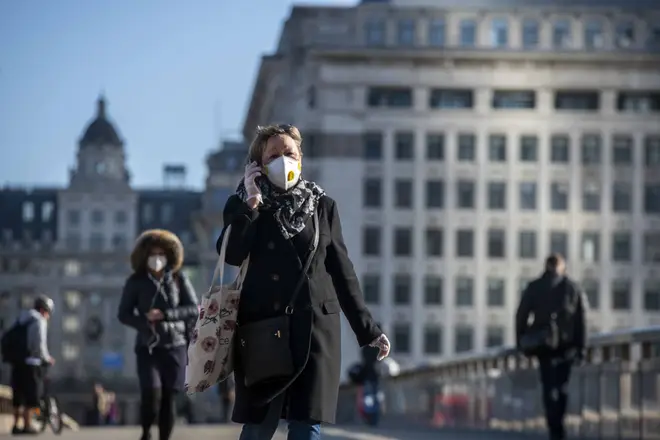
Clive Bull 1am - 4am
10 June 2020, 11:17

The widespread wearing of face masks keeps the coronavirus R rate below 1.0 and prevents further waves when combined with lockdowns, new research suggests.
A modelling study from the universities of Cambridge and Greenwich indicates that lockdowns alone will not stop the resurgence of Covid-19.
Researchers say even homemade masks with limited effectiveness can dramatically reduce transmission rates if worn by enough people, regardless of whether they show symptoms.
Experts say the R number in the UK is currently 0.7-0.9.
According to the study, 100 per cent mask adoption combined with on/off lockdowns prevented any further disease resurgence for the 18 months required for a possible vaccine.
The models suggest that - while the sooner the better - a policy of total face mask adoption can still prevent a second wave even if it is not instigated until 120 days after an epidemic begins.

Face coverings to be made mandatory on public transport in England
Researchers say masks that only capture 50% of exhaled droplets would still provide a "population-level benefit".
This was even if they quadrupled the wearer's own contamination risk through frequent face touching and mask adjustment - a highly unlikely scenario.
Lead author Dr Richard Stutt said: "Our analyses support the immediate and universal adoption of face masks by the public.
"If widespread face mask use by the public is combined with physical distancing and some lockdown, it may offer an acceptable way of managing the pandemic and re-opening economic activity long before there is a working vaccine."
Covid-19 is transmitted through airborne droplets that get exhaled by infectious people, particularly when talking, coughing or sneezing.
For the latest study, researchers worked to link the dynamics of spread between individuals with population-level models, to look at different scenarios of face mask adoption combined with periods of lockdown.

How to make your own face mask
The modelling included stages of infection and transmission via surfaces as well as air.
Researchers also considered negative aspects of mask use, such as increased face touching.
The reproduction, or R number is the number of people an infected individual passes the virus onto, needs to stay below 1.0 for the pandemic to slow.
The study, published in the Proceedings of the Royal Society A, found that if people wear masks when in public, it is twice as effective at reducing R than if masks are only worn after symptoms appear.
In all modelling scenarios, researchers found routine face mask use by 50% or more of the population reduced Covid-19 spread to an R less than 1.0.
This flattened future disease waves and allowed less-stringent lockdowns.
Listen & subscribe: Global Player | Apple Podcasts | Google Podcasts | Spotify
Viral spread reduced further as more people work masks when in public.
The researchers say homemade masks primarily reduce disease spread by catching the wearer's own virus particles, whereas inhaled air is often sucked in around the exposed sides of the mask.
Professor John Colvin, coauthor from the University of Greenwich, said: "There is a common perception that wearing a face mask means you consider others a danger.
"In fact, by wearing a mask you are primarily protecting others from yourself.
"Cultural and even political issues may stop people wearing face masks, so the message needs to be clear: 'my mask protects you, your mask protects me'.
"In the UK, the approach to face masks should go further than just public transport.
"The most effective way to restart daily life is to encourage everyone to wear some kind of mask whenever they are in public."